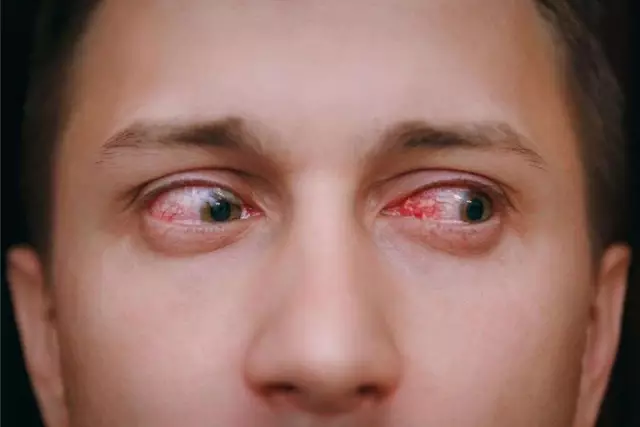- Author Rachel Wainwright [email protected].
- Public 2023-12-15 07:39.
- Last modified 2025-11-02 20:14.
Trichophytosis

Dermatophytosis, dermatomycosis, trichophytosis or ringworm are all names of one disease. The causative agent of this disease are fungi of the genus Trichiphyton. Trichophytosis affects the skin, nails and hair. The carriers of the disease are animals and people, mainly of children. It has been noticed that ringworm in a person infected from an animal proceeds in a more severe form.
The way of transmission of dermatomycosis is contact-household, through the use of objects and things contaminated with fungi, as well as contact with sick animals. Susceptibility to ringworm in humans increases in the presence of damage on the skin surface, reduced immunity, as well as with prolonged contact with the source of the disease, high humidity and a number of other adverse factors.
Types of trichophytosis
Depending on what type of pathogen contributed to the development of the disease, superficial and infiltrative-suppurative trichophytosis are distinguished.
Superficial ringworm occurs when infected with anthroponous dermapitis upon contact with a sick person. Most often, this type of disease is observed in children of young and middle age.
Infiltrative-suppurative dermatomycosis appears as a result of human infection with zoonotic parasites, the host of which is an animal. Here at risk are people working in agriculture, and by the nature of the service associated with caring for animals.
Symptoms of superficial trichophytosis or ringworm
With superficial trichophytosis, smooth skin, scalp and nails are affected. At the site of the introduction of the pathogen, a rounded red or pink spot appears. As the disease progresses, the spots become more and more.
A characteristic difference between rashes in humans with ringworm from other types of rashes is a roll of crusts, nodules and vesicles, outlining spots and slightly raised above the surface of the skin. Inside the spots, the skin remains unchanged, but peeling can be observed. Often, patients have itching in the lesions.
In cases where the fungus settles on the scalp, bald spots appear at the lesions: the hair thinns and breaks off. With dermatomycosis, nails fade, acquire a dirty gray color, a thickening of the nail plate occurs, which then begins to crumble.
Sometimes superficial ringworm becomes chronic. Basically, this happens in those individuals who, during the acute course of the disease, did not receive a full course of specific treatment. Chronic superficial trichophytosis is especially susceptible to adolescent girls. In this case, itching foci of a bluish tint with slight peeling are formed on the skin. On the head, small lesions with broken hairs inside them become noticeable.
Despite the external unattractiveness, trichophytosis or ringworm does not bring much harm to the human body.
Infiltrative-suppurative trichophytosis

Foci with trichophytosis of an infiltrative-suppurative type can appear on smooth skin and scalp. Often, the disease manifests itself in the mustache and beard area.
At the site of the introduction of the pathogen, purulent abscesses develop. Patients have a deterioration in well-being, body temperature rises, nearby lymph nodes increase and hair begins to fall out.
The foci of infection on smooth skin and in areas with hairline are round spots, dense and painful, with pronounced follicles with purulent contents. Cicatricial changes remaining after the healing of foci of dermatomycosis on the scalp contribute to the formation of foci of complete baldness.
Inguinal ringworm
A special line among the diseases caused by fungi is inguinal ringworm. If, with ordinary trichophytosis, lesions can be located on the surface of the skin of the arms, legs or trunk, then, as the name suggests, the disease develops in the groin area, affecting the anus, perineum, genitals and the inner surface of the thigh. Patients note soreness in these places, as well as the appearance of rashes and peeling. Infection with inguinal dermatomycosis occurs through contact and household means: through common items and through direct contact with a sick person.
Among the complaints are burning, itching and hyperemia in the perineum. In the lesion, a raised red rash appears, the skin becomes dry, it begins to peel off and crack.
Most often, men suffer from inguinal ringworm. The peak incidence occurs during the hot season.
Trichophytosis treatment
Depending on the type of pathogen, the severity and clinical manifestations of the disease, the treatment of trichophytosis or ringworm can be carried out both on an outpatient basis and in a hospital.
It should be remembered that, despite the availability of drugs, only a specialist should prescribe ringworm treatment, since many antifungal drugs can adversely affect liver function.

With mild degrees of trichophytosis, local treatment of lesions with ointments with antifungal effect is sufficient. These include Lamisil, Miceleks, Mikatin, Clotrimazole and a number of other drugs. A good result is given by lubrication with an alcoholic tincture of iodine or sulfur-salicylic ointment. The duration of the course of treatment for ringworm is one to two weeks; for the prevention of recurrence, ointments are used within a week after the disappearance of all symptoms.
Antifungal agents for oral administration are prescribed for deep lesions of the nails, skin and scalp. Griseofulvin and Nizoral have a good healing effect. Daily intake of the drug is advisable until the test for fungi becomes negative. Then the medicine is applied first every other day for two weeks, then twice a week for another 14 days.
In cases of an infiltrative-suppurative form of trichophytosis or ringworm against the background of antifungal therapy, lotions with solutions of silver nitrate or ichthyol are used.
If the nail plates are severely affected, then they must be removed.
Prevention of ringworm and its recurrence
A very important place in the prevention of trichophytosis is given to the observance of the rules of personal hygiene. It is not recommended to use other people's towels and bath accessories. When visiting baths, saunas, swimming pools, beaches and other places potentially dangerous in terms of fungal infection, it is necessary to use rubber slippers. Routine examination of animals by a veterinarian will allow timely detection of ringworm in pets.
If a person has ringworm, to prevent recurrence, his clothes are washed in hot water and, if possible, disinfected. In the room where he lives, all surfaces are treated with disinfectants.
YouTube video related to the article:
The information is generalized and provided for informational purposes only. At the first sign of illness, see your doctor. Self-medication is hazardous to health!






